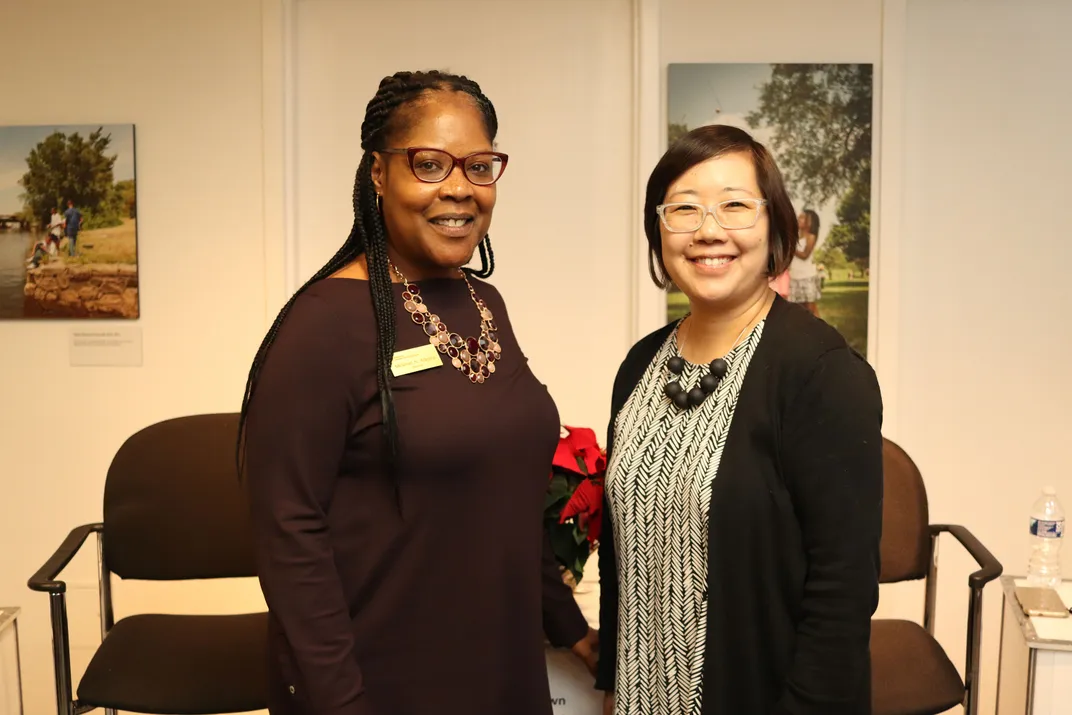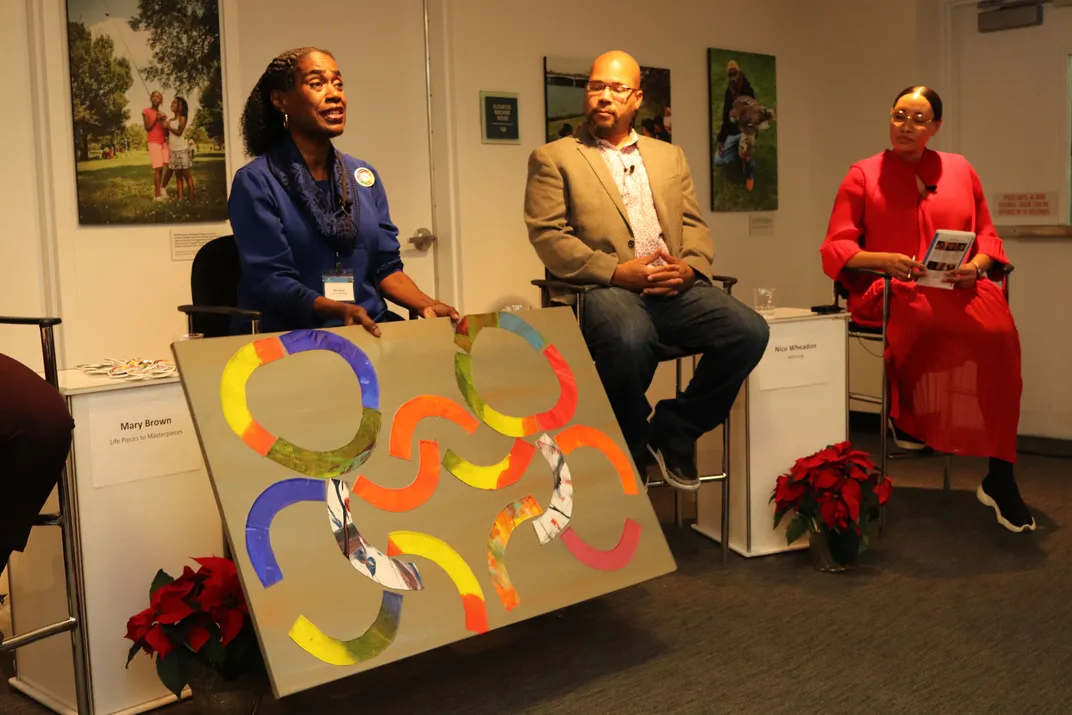Fifty Years Ago, the Idea of a Museum for the People Came of Age
A Smithsonian symposium asked experts to weigh in on the strength of the community museum and chart its way forward
/https://tf-cmsv2-smithsonianmag-media.s3.amazonaws.com/filer/f5/b7/f5b73051-97ec-4930-902a-e9c398b15c5b/sia-opa-1654r1-05a.jpg)
How should museums relate to their surroundings? What are the most meaningful ways for them to connect and work with their communities? Those questions, among others, were at the heart of an all-day symposium held recently at the Smithsonian’s Anacostia Community Museum in Washington, D.C., and jointly hosted by the Smithsonian Asian Pacific American Center (APAC). Dozens of attendees convened for a day of wide-ranging discussions about museum best practices for serving the public and to examine what the future of local and community museums might look like.
These questions date to the beginning of the community museum movement in the 1960s and remain foundational to the field. “You had all these social movements from the Civil Rights and Black Power movements to the antiwar movement, to the Women's movement, really challenging all kinds of American institutions, and museums were no exception to that,” explains Samir Meghelli, the museum’s chief curator and a coordinator of the symposium. “The idea was really to try to transform and re-envision the role that museums could play in communities and in society.”
The conference, “A Museum of the People: Museums and Their Communities—50 Year Later,” marked the anniversary of, and in many ways mirrored, a 1969 gathering in New York City. Representatives of community-based cultural institutions met to interrogate how to make museums more accessible, how to decolonize the collections and how to foster leadership that reflected the institutions’ communities. Among the attendees was John Kinard, the museum’s first director, then known as the Anacostia Neighborhood Museum, which was founded in 1967, and quickly took its place at the forefront of the movement. “Involvement is what is wanted and involvement can only be created if it is the community’s museum,” said S. Dillon Ripley, the Smithsonian secretary at the time and who proposed the idea. “It must be on the spot, participated in by the people who live there. Otherwise, the project will end up nothing more than a museum equivalent of a visiting book mobile.”

Emily Dennis Harvey, who co-organized the original symposium in New York and co-edited a book about it, spoke about her time as director of MUSE, an experimental offshoot of the Brooklyn’s Children Museum, which is seen as a foundational core to the community museum movement. The anger of era, she says, propelled these institutional changes.
In conversation with Harvey were Ron Chew, who formerly led the Wing Luke Museum of the Asian Pacific American Experience, Carlos Tortolero, who founded the National Museum of Mexican Art, and Kinshasha Holman Conwill, deputy director of the Smithsonian’s National Museum of African American History and Culture. These panelists spoke about the progress that’s been made in the past 50 years and of the work that is still needed to make museums welcoming and collaborative spaces. Conwill underscored the day’s mission, saying one lesson she’s learned throughout her career is, “Museums don’t mean anything if they don’t relate to the community.”
Echoes of the 1969 gathering reverberated throughout the symposium, noted Sterling Warren, a graduate student in museum studies and historical preservation at Morgan State University. “We are still talking about those things 50 years later,” he says. “There is no finality to those questions, these are things that we constantly have to think about and navigate as professionals in the field.”
Melanie Adams, the Anacostia Community Museum’s new director, focused a panel discussion on how to implement public programs that involve and resonate with visitors. Jody Sowell, director of exhibitions and research at the Missouri Historical Society, says his institution has prioritized making the museum accessible to those with disabilities. Brenda Tindal, now working for the International African American Museum, says unique programming she used to organize at the Levine Museum of the New South includes hosting dinners meant to foster inter-community dialogue. Tindal used zip codes to seat people together who might otherwise never have spent time with each other.

Dina Bailey, of the International Coalition of Sites of Conscience, recalled a formative experience while working on an exhibition about lynching at the National Underground Railroad Freedom Center. Seeing how visitors connected with the exhibit and how it sparked conversations in and about their lives, Bailey knew her mission would be “to go into communities and help them find whatever that story was that could then be a jumping off point for family members, for friends, for people to talk about what really happened in their lives and how it affected their present.”
Alongside leaders from community art spaces, including Self Help Graphics & Art from Los Angeles and New Haven’s NXTHVN, Mary Brown, executive director of Washington, D.C.’s Life Pieces to Masterpieces, spoke about how her organization helps African American boys and young men explore their artistic potential.
The day’s keynote panel, moderated by Teng Chamchumrus of the Smithsonian, featured leaders from outside the traditional museum field whose work focuses on serving communities. Linnea Hegarty of the DC Public Library explained how libraries are no longer just spaces to check out books and how DCPL’s staff is expanding its skillset to address the different needs of library patrons, many of whom are experiencing or have experienced homelessness.
Stacey Karpen Dohn, who works at Whitman-Walker Health, a medical care center that focuses primarily on the LGBTQ community and those living with HIV, spoke about training her staff in “cultural humility,” to better understand their place in working with communities of which they are not a part, and training them to be open and to listen to their patients. Chamchumrus—inspired by Whitman-Walker’s dedication to making their centers more than doctors’ offices, but rather places for patients to gather and spend time together—sees that effort as a model for fostering community at museums.
Angel Thompson of the National Parks Foundation was intrigued by the question of engaging nontraditional visitors. “You have to think about accessibility. . . how do you make an exhibit or a museum more accessible to people who may not be able to see, to people who may not speak your language,” she says.
The symposium wrapped up as the sun set, with Lisa Sasaki, director of the Smithsonian Asian Pacific American Center, offering a few key takeaways. Among them, she emphasized the need for museum workers to take care of themselves and to avoid burnout with the practice of resiliency training. She also highlighted the importance of continually keeping communities engaged—to not just offer one-off exhibits or programming but to build lasting relationships.
“Hell yes, we have moved forward over the last 50 years,” Sasaki said. “Since 1969, we’ve developed a heck of a lot of tools, and programs, and professionals who are in this room, networks, allies who are doing things that are so inspirational that we can move forward. We are listening. Sometimes we may not be understanding fully but at least we’re listening. We are measuring. And we’re asking questions and not just telling people what we want them to hear.”